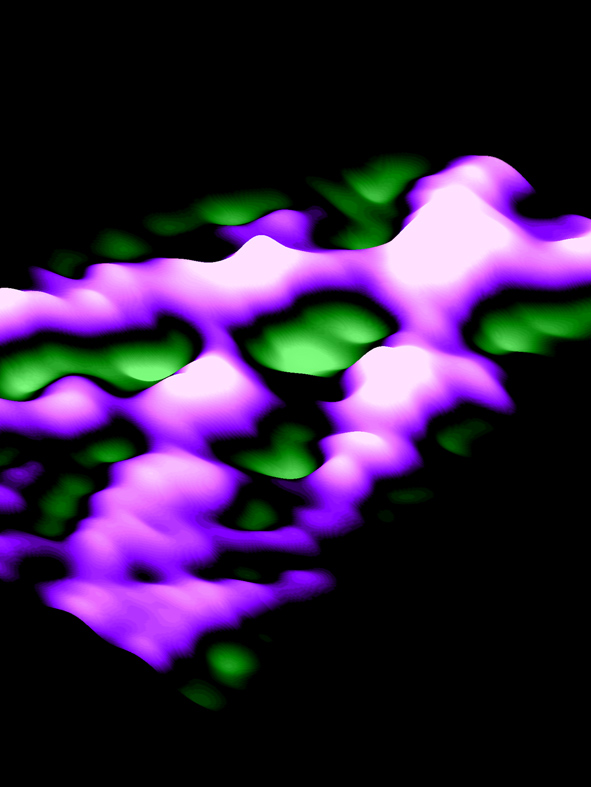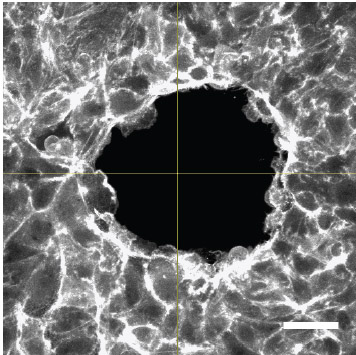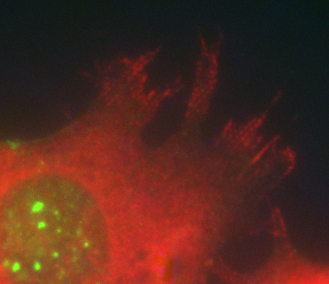Research news
A step towards repairing the central nervous system
 Researchers from IBEC and the University of Barcelona have revealed a promising new strategy for regenerating the central nervous system, in a paper published in the journal Biomaterials.
Researchers from IBEC and the University of Barcelona have revealed a promising new strategy for regenerating the central nervous system, in a paper published in the journal Biomaterials.
A promising strategy to target malaria
 A paper by the Nanobioengineering group reveals a new strategy for targeted malaria treatment that doesn’t rely on the use of expensive antibodies.
A paper by the Nanobioengineering group reveals a new strategy for targeted malaria treatment that doesn’t rely on the use of expensive antibodies.
Imaging the electrocatalytic activity of single nanoparticles
 An IBEC researcher has collaborated on a paper published in Nature Nanotechnology that outlines an effective new way to characterize and improve nanoparticle catalysts, which play essential roles in biomedicine, industry and everyday life by affecting the rate at which chemical reactions take place.
An IBEC researcher has collaborated on a paper published in Nature Nanotechnology that outlines an effective new way to characterize and improve nanoparticle catalysts, which play essential roles in biomedicine, industry and everyday life by affecting the rate at which chemical reactions take place.
Nanoparticle catalysts are used in making polymers and biofuels, synthesising new drugs, pollution control devices and fuel cell technology, and both characterising them and finding more effective ones is vital.
Smart biomaterial promotes angiogenesis
 IBEC researchers have stuck tissue engineering gold with the creation of a new ‘smart’ biomaterial that triggers angiogenesis by providing the biochemical and mechanical cues needed for the process to begin.
IBEC researchers have stuck tissue engineering gold with the creation of a new ‘smart’ biomaterial that triggers angiogenesis by providing the biochemical and mechanical cues needed for the process to begin.
Researchers in Josep Planell’s Biomaterials for Regenerative Therapies group, in a paper led by Elisabeth Engel, reveal their calcium phosphate glass/PLA composite that itself promotes the mobilization and differentiation of endothelial progenitor cells – those that become the cells making up the lining of blood vessels.
“In regenerative medicine, successful tissue repair hinges on being able to recreate the right environment, so that the biomaterial not only acts as a scaffold for the new tissue but also contributes to the activation of the regeneration process,” explains Elizabeth.
Scientists discover a new type of wave in living tissues
 The Integrative Cell and Tissue Dynamics group published their latest results in the quest to understand how the cells in our bodies collectively migrate in Nature Physics this week.
The Integrative Cell and Tissue Dynamics group published their latest results in the quest to understand how the cells in our bodies collectively migrate in Nature Physics this week.
In studying the motion of cell clusters, the researchers detected evidence of wave-like crests of deformation launched at the edges of the clusters and propagating from cell to cell at roughly twice the speed at which cells were moving.
‘Fingerprinting’ nanoscale objects and viruses
IBEC’s Nanoscale Bioelectrical Characterisation group are celebrating the publication of their latest results in Nature Materials this week.
In their paper “Label-free identification of single dielectric nanoparticles and viruses with ultraweak polarization forces”, Laura Fumagalli, group leader Gabriel Gomila and their colleagues present their work on a new technique to identify nano-objects such as viruses without the need for labeling, which could offer a breakthrough for biomedical diagnostics, environmental protection and nano-electronics.
Cells mind the gap: cell protrusions close gaps in epithelia
 Epithelial tissues line cavities and the surfaces of structures throughout the body, and also form many glands. During development, injury and in various disease conditions, gaps appear in the epidermis, which have to be quickly filled in.
Epithelial tissues line cavities and the surfaces of structures throughout the body, and also form many glands. During development, injury and in various disease conditions, gaps appear in the epidermis, which have to be quickly filled in.
The timely closure of the gaps that occur in these cell layers has been studied in great detail, and two possible mechanisms have been suggested; the closure of cells like the strings of a purse over a gap, and the extension of cellular protrusions by the cells surrounding the gap, which will eventually seal it. Different molecular players have been found to be key components of these mechanisms.
How the nose knows
 The mammalian sense of smell is an excellent chemical sensing system that far outshines any man-made reproduction, so researchers have long been trying to analyze and recreate the animal olfactory system to develop artificial ‘noses’.
The mammalian sense of smell is an excellent chemical sensing system that far outshines any man-made reproduction, so researchers have long been trying to analyze and recreate the animal olfactory system to develop artificial ‘noses’.
Now researchers at IBEC have shed new light on this highly efficient system that could allow better chemical sensing systems with important applications in such critical areas as health, security or the food industry.








